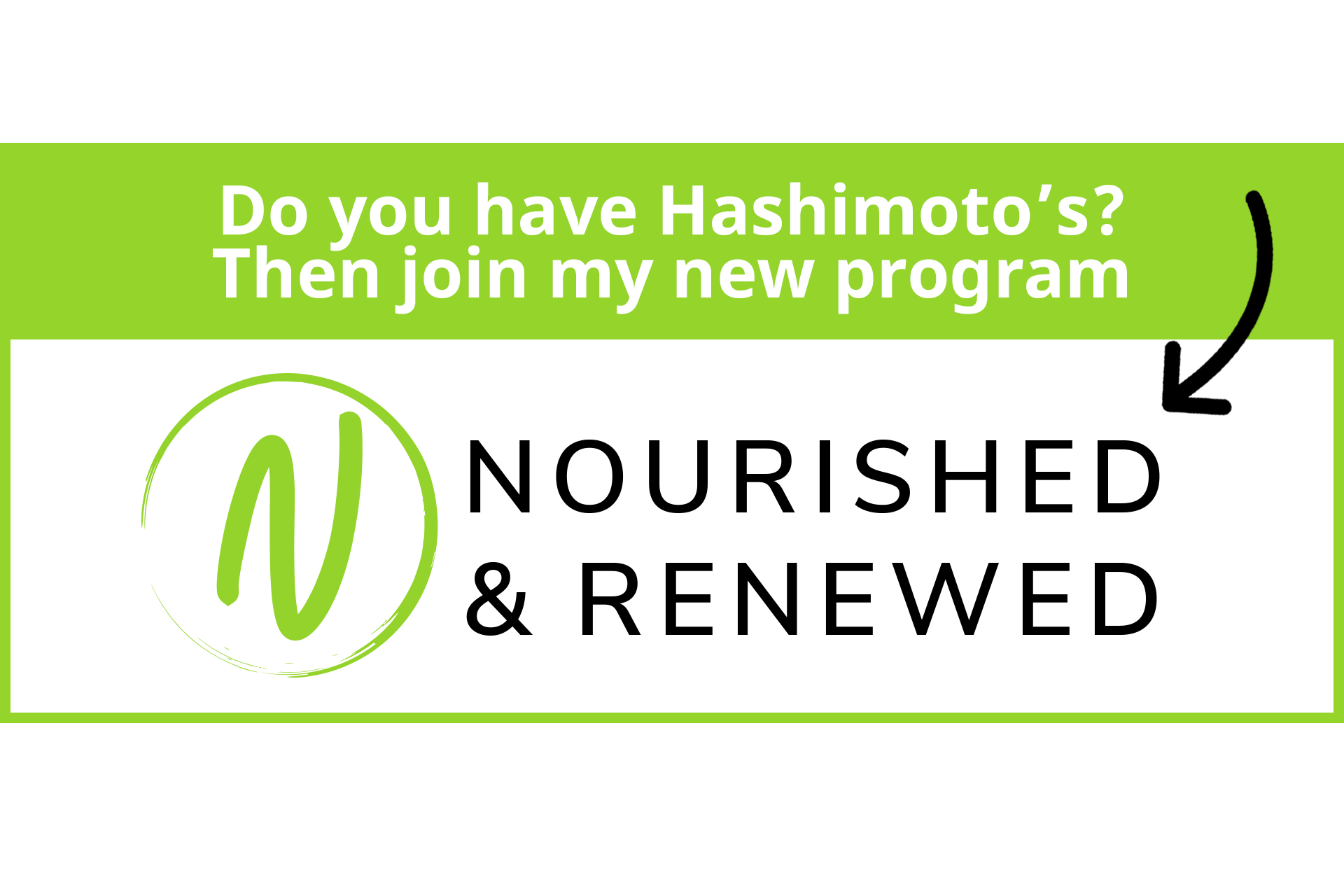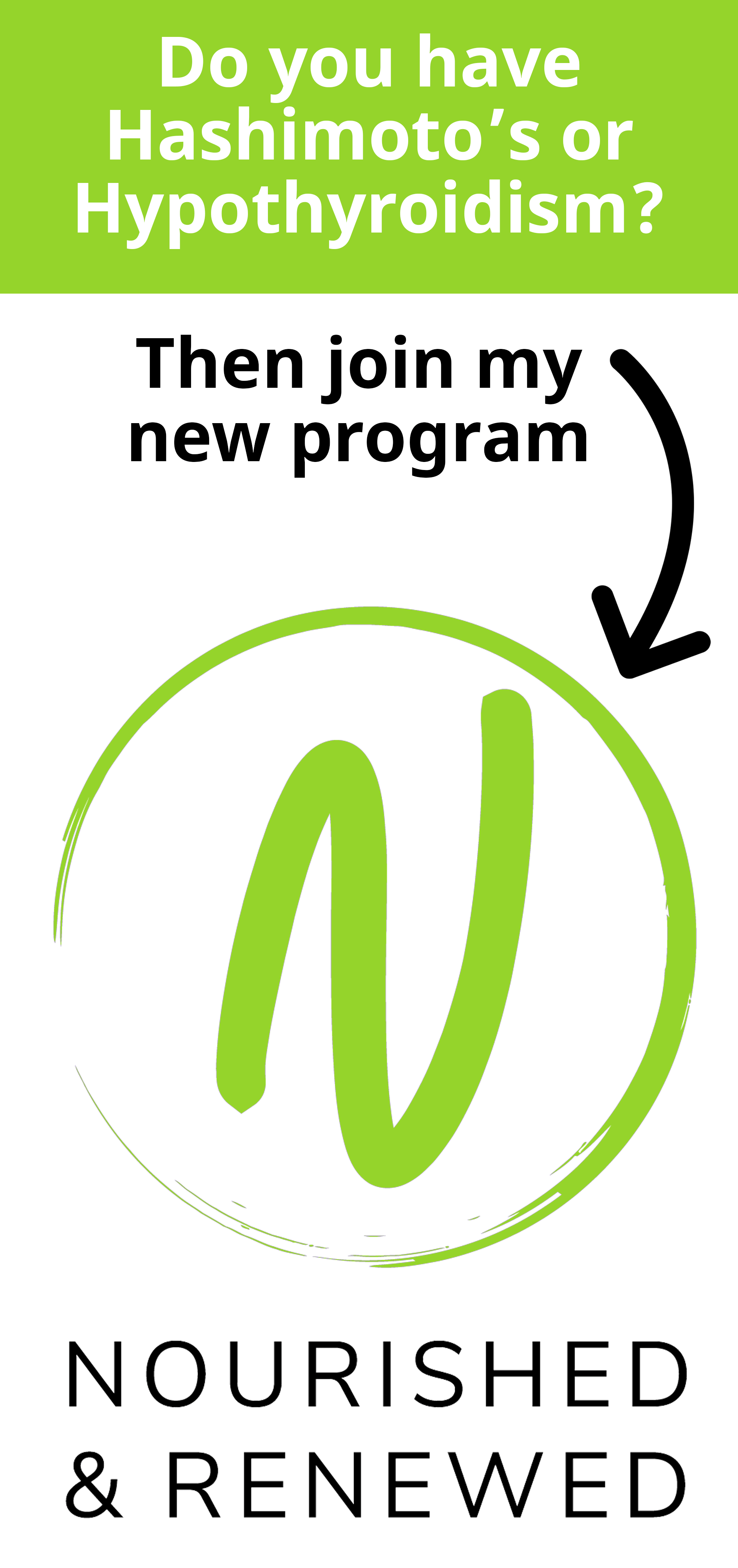Spring is finally, well, springing!
We can start to emerge from our winter cocoons and soak up the sunshine. That means we can begin building up our stores of vitamin D again.
I get that not everyone’s first thought of spring is the excellent opportunity to boost our vitamin D storage! Ha ha!
But, for those of us who have Hashimoto’s or other thyroid dysfunction, it is important to know that vitamin D (sometimes called “the sunshine vitamin”) is highly important, even more so than for the average person.
That’s because people with autoimmune thyroid conditions like Hashimoto’s and Grave’s diseases are more likely to be deficient in vitamin D.
Keep reading to find out more about the functions of vitamin D for health, how vitamin D deficiency affects people with Hashimoto’s, plus how to find out if you are deficient and what can be done about it.

Understanding Vitamin D
Vitamin D Properties
Before I go into the health details and benefits of vitamin D, I want to first explain briefly the type of vitamin that vitamin D is.
OK, so there are two main types of vitamins - water-soluble vitamins and fat soluble vitamins.
Water-soluble vitamins like vitamin C and B vitamins dissolve in water, don’t store well and are used as they are digested.
In contrast, fat-soluble vitamins are most abundant in high-fat foods and are much better absorbed into your bloodstream when you eat them with fat.
They store well in the body and are drawn out for use as needed. Examples of fat-soluble vitamins are A, D, E and K.
With important functions and a variety of health and disease prevention roles, our fat-soluble vitamins are an important part of our diet.
It is for this reason that our fat-soluble vitamins are absorbed better when consumed with fats or oils such as olive oil, avocado, nuts, and seeds.

Vitamin D Functions
Two major functions of vitamin D are
- maintaining bone health by regulating and triggering the absorption of calcium and phosphorus
- strengthening the immune system.
One way in which it plays a role in the immune system is the indication that it triggers activity in both white blood cells and T cells (sometimes considered the killers of the immune system).
Many studies have found strong links between high vitamin D levels and decreased inflammation.
Although it previously wasn’t understood if inflammation caused lower D levels or low D levels caused more inflammation, there is more and more evidence that the vitamin itself has anti-inflammatory effects.
Vitamin D deficient individuals are at higher risk for diabetes because of its role in blood sugar regulation.
Also, D is considered a “pro-hormone,” meaning it can be converted into a hormone, so it is an important nutrient for hormone balancing.
According to the Centers for Disease Control (CDC), active vitamin D functions as a hormone. I find this particularly interesting.
But, it makes sense.
Vitamin D helps regulate adrenal hormones - adrenaline, norepinephrine - and it supports production of dopamine in the brain, protecting the brain from becoming depleted in the feel-good hormone, serotonin.
As you can imagine, this makes vitamin D highly important for mood regulation and preventing depression.
As you can probably tell by all of this info in the article so far, there is so much more to vitamin D than meets the eye.
You need adequate cholesterol, sun exposure, calcium, phosphorus and much more to make vitamin D work at its best for you.

And the bottom line is that vitamin D is so crucial for our health from the inside out.
Guess what - we have learned all of that goodness before we’ve even looked to its benefits for the thyroid!
How We Obtain Vitamin D
Getting Vitamin D from the Sun
We get vitamin D from two main sources. The first in from the sun. Actually, to be fair, we make it from the sun. And, it’s a rather complicated, but interesting process.
Stick with me on this science stuff for a second.
Upon exposure to UVB (Ultraviolet B) radiation from the sun, previtamin D3 is synthesized in the skin, primarily in keratinocytes in the layers of the epidermis.
Basically, that means cells in the skin.
Previtamin D3 from the sun then forms vitamin D3 (cholecalciferol), which is subsequently transported into the bloodstream circulation by means of a binding protein.
Previtamin D3 is so amazing it can also form various “photoproducts” which are biologically inactive but may actually protect the skin from prolonged sun exposure! Almost like a natural sunscreen built in to our skin!
Sun exposure may actually afford several biological functions in skin for maintaining good health, including regulating the proliferation and differentiation of keratinocytes, hair follicle cycling, and tumor suppression.
Moreover, vitamin D is known to modulate inflammation and may be involved in wound healing.
It’s important to know that variables affect skin synthesis of vitamin D, including latitude, season, time of day, degree of skin pigmentation, age, amount of skin exposed, and sunscreen use.

Foods Rich in Vitamin D
Our other source of vitamin D is from foods, in two forms.
D2 comes from plants, mainly mushrooms.
D3 comes from animal sources, such as eggs and fish. It is also the form that is created after sun exposure.
Vitamin D2 (ergocalciferol): Found in mushrooms and some plants.
Vitamin D3 (cholecalciferol): Found in animal-sourced foods, such as eggs and fish oil, and produced by your skin when exposed to sunlight.
I will go in to more details about the vitamin D-rich foods in just a bit.
Vitamin D Deficiency Stats
Vitamin D deficiency is very common.
It's estimated that about 1 billion people worldwide have low levels of the vitamin in their blood.
Here are 7 common risk factors for vitamin D deficiency:
- Having dark skin.
- Being elderly.
- Being overweight or obese.
- Not eating much fish or dairy.
- Living far from the equator where there is little sun year-round.
- Always using sunscreen when going out.
- Staying indoors.
- Fat malabsorption problems.
Low Vitamin D Means Poor Thyroid Function
Researchers don’t yet fully understand the relationship between vitamin D and thyroid function because we haven’t found a direct way in which the vitamin supports what the thyroid does for us.
A major role of the thyroid gland is to produce the thyroid hormones triiodothyronine (T3) and thyroxine (T4).
The thyroid is only triggered to do this by another hormone in the pituitary gland, thyroid-stimulating hormone (TSH).
But when vitamin D is deficient, TSH levels have been found to be low, indicating that low D levels do not allow the thyroid to function as it should.
If the TSH is low, then levels of T4 (storage) and T3 (active) hormones will be low too.
Vitamin D Deficiency and Autoimmune Thyroid Disease
Perhaps most important for anyone suffering from Hashimoto’s or Grave’s - studies have found that people with autoimmune thyroid disorders were much more likely to be vitamin D deficient.
They were more than 40% more likely to be deficient in vitamin D than a “healthy” person.
There is no real way at this point to understand the cause and effect of this relationship but there is a clear correlation.
Vitamin D deficiency also has a correlation with the presence of thyroid antibodies, those pesky little proteins that are the attackers of the thyroid that cause Hashimoto’s. This may be a huge reason why that 40% stat makes sense.
As I mentioned earlier, vitamin D levels can impact inflammation in the body.
Although this can affect anyone, it is especially important for someone with Hashimoto’s disease, because they are at higher risk of having higher numbers of inflammatory cells circulating throughout the body.

How To Know If You’re Deficient
Understand the Symptoms of Vitamin D Deficiency
The signs of vitamin D deficiency can be hard to notice, partly because they can be so common and partly because the symptoms are similar to other deficiencies.
The main signs of vitamin D deficiency are:
- Fatigue
- Bone pain or chronic back pain
- Muscle weakness, aches or cramps
- Changes in mood like depression
- Becoming sick often
- Poor wound healing
- Hair loss

What you may not see are the internal effects or disease risk associated with low D levels, including:
- Heart disease
- Diabetes
- Increased risk of certain cancers (including thyroid cancer)
- Multiple sclerosis
- Autoimmune disease
Test for Vitamin D Deficiency
The best way to know for sure, is to get tested for your vitamin D level in your blood.
Unfortunately, many insurance companies do not cover the cost of this test. Which is a tragedy, given that this test gives us such incredible insight to so many health conditions and functions of the body.
And, certainly - in my experience personally and professionally - given vitamin D’s relationship to the thyroid and the number of people experiencing thyroid disorders and vitamin D deficiency in our country - this testing can be incredibly useful.
That being said, one vitamin D test may not give you the full picture.
This is because, as we learned before, vitamin D is stored in our fat for use later but we can run low on these stores.
Typically, we are at our lowest levels in March and our highest levels in October.
This makes sense when we think about when we tend to get more sun but means that testing at different times of the year may yield very different results.
I suggest getting two baseline Vitamin D tests through True Health Labs which you can order yourself and are relatively inexpensive.
One test should be conducted in the spring to see what your needs for Vitamin D are going in to the sunshine months of the year.
The other should be in early fall to see how well you obtained vitamin D from sunshine exposure during the summer.

Supplementing Vitamin D and What to Look for
Quality Matters
Supplementing with vitamin D if you’re deficient is an easy way to boost those levels and it can be effective if you do it right. But it can be confusing with all the products out there.
First, it’s important to make sure you are using a version that contains the D3 form of the vitamin. If you remember, this is the form we get from sunlight and is best utilized by the human body.
One thing to look out for is what kind of carrier is used in your vitamin D supplement.
In this case, it needs to be a fat because D is fat-soluble.
In some products, this may be soybean or corn oil, which are often genetically modified. Others may contain olive, sunflower or even castor oil. Stay away from these poor-quality oil carriers in your supplements.

How Much Vitamin D Should You Take
The Vitamin D Society is a Canadian non-profit group organization who notes that 2,000 IU is a safe daily amount for most adults (including pregnant women).
Some people find they may only need to supplement in certain months, usually in fall and winter, depending on where you live.
However, I find that most people with autoimmune illnesses (especially Hashimoto’s - myself included!) need to supplement with vitamin D year-round.
Why?
Well, as already discussed - those of us with Hashimoto’s in particular just tend to become deficient rather quickly without supplementation. (I see that all the time with my clients who do regular testing with and without regular supplementation.)
Whether you have Hashimoto’s or not, before you start a supplement, I suggest you use testing to determine your starting levels.
- If levels of vitamin D are adequate (30-50 ng/mL), then a maintenance dose of approximately 2,000 IU per day is appropriate.
- If levels of vitamin D are low (less than 30 ng/mL), you want to start with a loading dose of D3 plus K2 for enhanced absorption of vitamin D.
And If your levels are low, my preferred supplement is Metagenics D3 5,000 + K.
This formula provides 5,000 IU per softgel of vitamin D (as D3) and bioavailable forms of vitamin K2 (menaquinone-7) to enhance absorption. (You can purchase this vitamin D using the code FAMILY at checkout.)
After a couple months, and possibly retesting, you can go down to the maintenance dose.
Everyone’s needs are different, so working with a practitioner who is board certified in holistic nutrition is your best bet!

Ok, Now Vitamin D From Food!
Although supplementation may seem like an easy fix, it is important to try getting your D from a combination of sunshine and food. This is partly because we utilize naturally obtained nutrients better than from pills.
It is nearly impossible to overdo it on vitamin D from consuming foods rich in vitamin D, unlike with supplementation.
Our body just recognizes the vitamin D from sunshine and food more clearly.
If you go out of your way to include these foods below, you might see great overall health benefits.
The natural foods listed here are actually nutrient-dense “super foods”.
If you have autoimmune disease or Hashimoto’s, the more frequently you can consume these foods, the better, really.
Natural Sources
| Cod liver oil | ~400-1000 IU vitamin D3 (per teaspoon) |
| Egg yolk | ~20 IU vitamin D3 or D2 (per yolk) |
| Mackerel (canned) | ~250 IU vitamin D3 (per 3.5 oz) |
| Wild salmon (canned) | ~300-600 IU vitamin D3 (per 3.5 oz) |
| Salmon (fresh farmed) | ~100-250 IU vitamin D3 or D2 (per 3.5 oz) |
| Sardines (canned) | ~300 IU vitamin D3 (per 3.5 oz) |
| Shiitake mushrooms (fresh) | ~100 IU vitamin D2 (per 3.5 oz) |
| Shiitake mushrooms (sun dried) | ~1600 IU vitamin D2 (per 3.5 oz) |
| Sunlight/UVB radiation | ~20,000 IU vitamin D3 (per 1 MED)** |
| Wild, pole-caught albacore tuna (canned) | ~230 IU vitamin D3 (per 3.5 oz) |
Fortified Foods
| Fortified breakfast cereals | ~100 IU vitamin D3 (per serving) |
| Fortified butter | 56 IU vitamin D3 (per 3.5 oz) |
| Fortified cheeses | 100 IU vitamin D3 (per 3 oz) |
| Fortified milk | 100 IU vitamin D3 (per 8 oz) |
| Fortified orange juice | 100 IU vitamin D3 (per 8 oz) |
| Fortified yogurts | 100 IU vitamin D3 (per 8 oz) |
| Infant formulas | 100 IU vitamin D3 (per 8 oz) |
*Table source https://www.ncbi.nlm.nih.gov/pmc/articles/PMC3571641. **Minimal erythemal dose (MED) in a bathing suit. Exposure of arms and legs to 0.5 MED is equivalent to ingesting ~3000 IU vitamin D3.
You may have noticed that there are foods on this Fortified foods list that claim to be high in vitamin D, but these foods actually are not naturally high in vitamin D.
(“Fortified” means it’s been added to a food that wouldn’t naturally contain it; while “enriched” means that a nutrient that was stripped out during processing was added back in, if you were wondering.)
There are a few problems with fortified foods like this, which is a bummer since it sounds like an easy fix, but of course it’s never that easy, right?
As I said, fortified foods contain nutrients that weren’t originally in there. But nutrients don’t function independently from each other.
A nutrient works best with other nutrients that it would naturally be found with.
When you just jam a nutrient in there, it doesn’t have its buddies to help it do its best work.
Also, as you can probably imagine, processed food companies are not going to use the best quality of these nutrients.
They are going to use the cheapest form, which may not be as easily utilized as the real deal.

Sunshine is Your Friend
Between a small amount of foods containing vitamin D and being cooped up away from the sunshine parts of the year, it’s no wonder so many Americans are lacking in this vital nutrient.
But with Hashimoto’s raising that risk of deficiency, it becomes that much more important to find ways to get enough vitamin D.
While food and supplements certainly help, it is clear that spending time in the sun is not only the best way to bring up your levels, it’s also the most fun way.
So, as the weather gives us more opportunities, take advantage of the health benefits of getting outside whenever, wherever and however you can.
If these tips are not enough to help you out with an ongoing vitamin D deficiency, and especially if your levels are low and you have Hashimoto’s, let’s chat.
If you want to tackle your total health and address other possible thyroid challenges at your own pace and create your new foundation for living healthfully with Hashimoto's, I recommend my 30-day program: Nourished and Renewed with Hashimoto's.
Are you ready to turn your life around and feel healthy, happy and vibrant?







